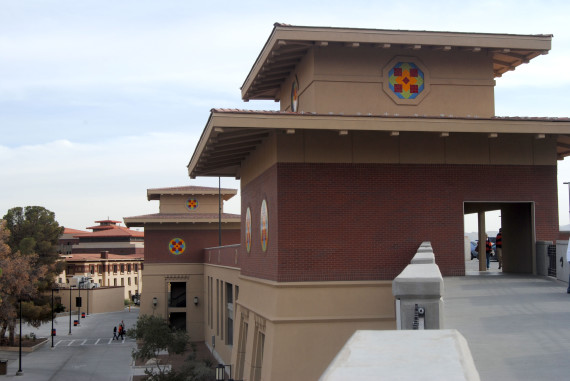Editor’s note: This is part of a three-part series explores the 2012 Campus Master Plan.
The current campus transformation has led the beauty of UTEP’s architecture to be masked by fences, bulldozers and hard hats. The construction has left the university looking like a large sandbox.
After the university’s first building burned down in Fort Bliss in 1916, Dean Stephen Howard Worrell chose UTEP’s current location as the site for the future of the university. However the idea behind UTEP’s Bhutanese architecture is the doing of Dean Worrell’s wife Katherine Worrell. She was inspired by a National Geographic article in 1914 called “Castles in the Air,” which spoke about Bhutan’s landscape.
Massive battered walls, deep overhangs, high inset windows and mosaic tiles is what Henry Trost, an accomplished El Paso architect, incorporated to the universities first building in 1917. This was all to bring the Bhutanese style architecture to UTEP, then known as The College of Mines and Metallurgy.
With this rich architectural history, the future landscape of the university is always under question.
The future landscape of the university is always under question due to the constant efforts to expand the university campus.”
The Campus Master Plan states: “As the university continues to grow, and programs become much larger and more complex to accommodate modern teaching and research, extreme care must be used in the siting, massing and detailing of future buildings in order to maintain the integrity of the campus.”
Associate Vice President for Business Affairs Greg McNicol said that this form of architecture is perfect for our region and that it is here to stay.
He also said the style reminds him of the pueblos that were built by the Native Americans.
“They didn’t have the overhangs like ours do but that works well in our climate. But the architecture works well here, the deep recessed windows work well here, and I think that is what makes it easier to comply because it is a good architecture style for this region,” McNicol said.
This natural desert look is something that both the university and Lake/Flato and Ten Eyck architecture firms are working on for the campus. How the campus will be constructed is modeled after a project conducted by the same firm at Arizona State University- Polytechnic campus.
McNicol said that although the new buildings might not be exact replicas of the other buildings they will all share some similarities.
“I like the sense of things looking like they somewhat belong I don’t want them to all look the same and I think we have done a pretty good job of making sure that each building is unique enough to stand on its own,” McNicol said.
Sophomore multimedia journalism major Amy Licerio acknowledges the similarities of the buildings and respects the differences of the campus architecture.
“I think things look better when it is uniformed, and it is nice when you come onto campus and it all looks the same. It shows that our money is being put to good use,” Licerio said.
Licerio said she admires the uniqueness of the architecture.
“In a city like El Paso it’s great and it’s different. It goes with the geography of where we are at, and I think that in a city where downtown is the only place where you find distinct architecture, UTEP really stands out. This campus is not an eye sore and I am so proud of that.”
McNicol has seen firsthand how UTEP’s buildings are inspired by Bhutan’s architecture. He traveled to Bhutan in 2005 and studied the architecture. He shared how UTEP’s newest buildings, the College of Health Science and Nursing and the Chemistry and Computer Science building, are a modern interpretation of the Bhutanese influence. The fort like structures, open spaces, and the L shape buildings are all a part of this new modern Bhutanese architecture.
“I am glad we are going to a style of landscaping that respects the desert that we live in and that too reflects the way the Bhutanese people built their buildings into nature. We are going to have green spaces where we come together (to) celebrate being a miner but at the same time we are going to move back towards an embellished desert look,” McNicol said.
To look at the complete Campus Master Plan 2011 visit masterplan.utep.edu.
Amanda Guillen may be reached at [email protected].







